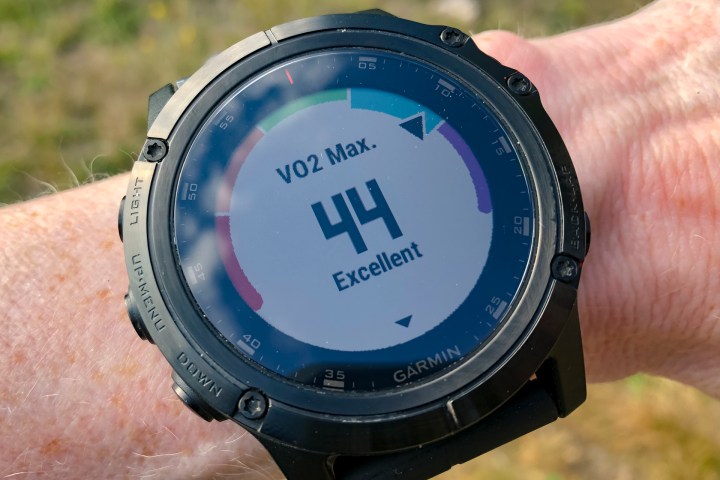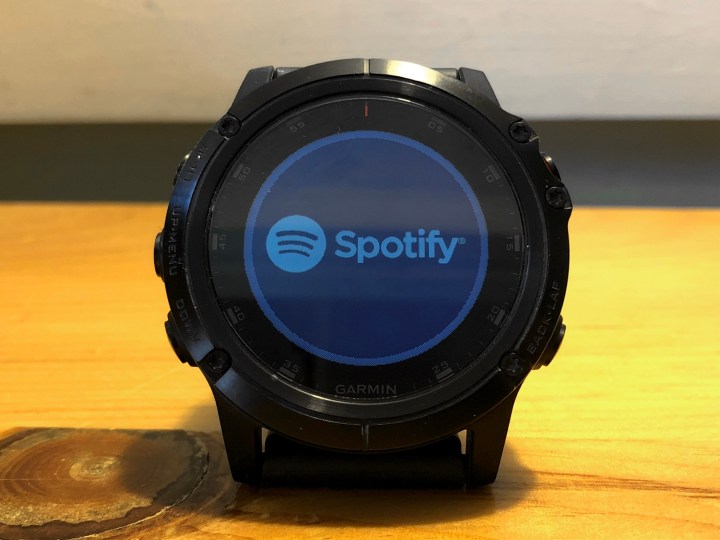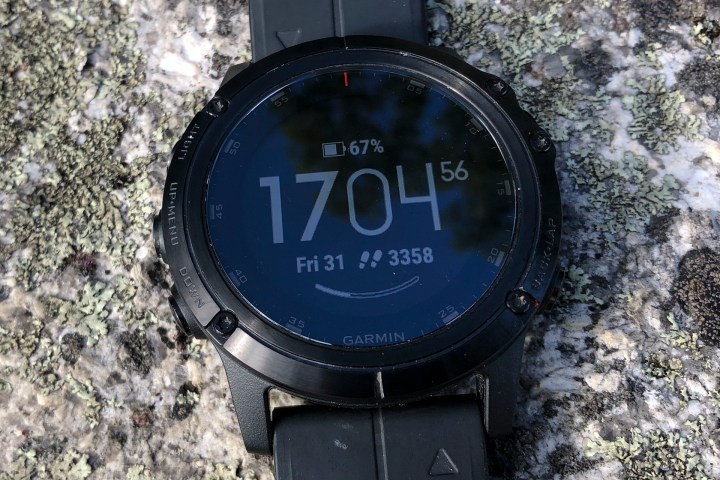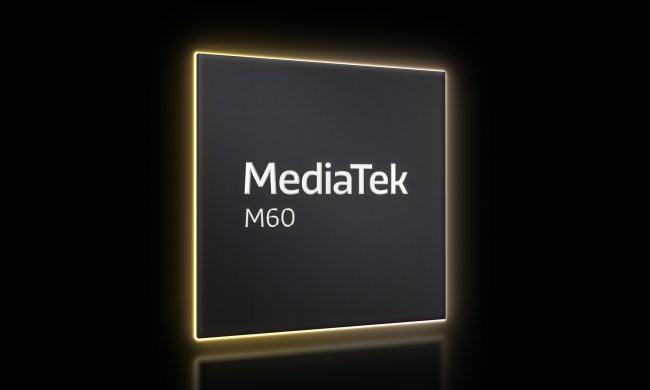- Color topographic maps are handy
- Music storage with Spotify support
- Lots of performance metrics
- Long battery life
- Nearly perfect GPS accuracy
- Music transfer is clunky
- Expensive
Garmin is known for pushing the limits on size and packing everything it can into its Fenix GPS multisport watches. The story hasn’t changed in 2018 with the new Fenix 5X Plus, which is one of the largest fitness watches on the market — and has a features list longer than Al Capone’s rap sheet. If you want it all, the Fenix 5X Plus is the watch for you.
It’s not all roses, though. The Fenix 5X Plus is not only the biggest fitness watch you’ll wear, it is likely one of the most expensive with a starting price tag of $850. Do the abundant features justify the expense? Let’s dig into the details to find out.
Editor’s note: We’ve added a section about Spotify integration into this review.
Rugged design, scratch-resistant display
Garmin’s Fenix watches are known for their big, burly size and characteristically rugged look. Just like last year’s Fenix 5X, the 5X Plus measures a whopping 51mm across and weighs 96 grams, making it 55 percent larger and twice as heavy as the Apple Watch Series 3. There’s no way to wear the Fenix discreetly — you either get used to people commenting about your giant watch, or you learn to wear it only when exercising.
Even though it is big, Garmin still does its best to make the watch look stylish. The base Fenix 5X Plus model is equipped with a sleek black stainless steel bezel and a black silicone band that is comfortable to wear. The 26mm QuickFit bands are interchangeable, so you can change around the colors or swap the standard silicone band for a leather or metal one.
The highlight, however, is the color sapphire display that is readable in sunlight and resists scratches. And resist it did. We wore the Fenix 5X Plus around the clock and didn’t hold back on any of our activities. At the end of a month, the display remained flawless.
Nearly perfect GPS performance, customizable interface
Garmin is a veteran in the GPS watch business and it shows. We hardly encountered any problems with GPS performance using the Fenix 5X Plus.
Fenix watches are known for their big, burly size and characteristically rugged look.
As long as we were in a reasonably open area and not in a dense forest, GPS lock-on was quick. In an open area, we never had to wait more than 10-15 seconds thanks to the combination of GPS, Glonass, and Galileo satellite connectivity. The metrics recorded by the watch when we were running, hiking, biking, and kayaking were dead on as well.
The only time the GPS struggled was when we were swimming in open water. The post-exercise stroke count, health metrics, and temperature data were accurate, but the watch was off on position tracking. The distance covered and the path recorded by the watch did not match the route we took, especially on short distances. Part of the issue is the water. With every stroke, your watch goes underwater and the GPS signal is attenuated. Garmin needs to compensate for this poor signal in order to improve the accuracy of the track.

Other than this small shortcoming, the Fenix 5X Plus was enjoyable to use. The interface is responsive and easy to navigate — once you get used to how the up/down and back/forward buttons work — but we do wish it had a touchscreen display for further simplicity.
One word we’d use to describe the interface is customizable. It is the cornerstone of the Fenix 5X Plus experience and is integrated into every corner of the software. From watch faces to widgets, almost everything you see can be changed to suit your needs. If you manage to find a metric that is missing, you can add new features using the Garmin Connect IQ smartphone app.
Sports tracking and performance analysis
Similar to the previous Fenix 5 models, the 5X Plus lives up to its multi-sport branding with support for 38 different sports including walking, running, swimming, skiing, paddling, biking, golf, and others.
You can add even more sport modes by downloading apps from Connect IQ. If you are overwhelmed with the choices, no problem. You can customize the list with the sports you participate in most frequently, so you don’t have to scroll through a ton of choices you won’t use.

The Fenix 5X Plus is unrivaled when it comes to the metrics it measures and the data it can show you while you are exercising. There are an astounding number of data screens you can scroll through. You can check your heart rate, see your distance traveled, and even see your location on a topographical map.
Best of all, you can add or remove these data screens depending on the metrics that you want to see while exercising. This flexibility is a big win in our books. It lets you dial down the watch when you don’t need a ton of data and then expand those options when you take your training to the next level.
With up to 70 hours of battery life, the Fenix 5X Plus is an ideal long distance training partner.
In a first for Garmin, the Fenix 5X Plus ships with a pulse oximetry sensor that will measure blood oxygen saturation (SpO2) levels. For most people, this sensor won’t provide any meaningful data, but alpinists who are climbing at high elevations can use this measurement to gauge their altitude acclimation. The Pulse Ox on the Fenix 5X Plus works just like the finger probes you see in a hospital. Both devices use light to measure blood oxygen saturation, which is reported as a percentage — the higher the percentage, the better your oxygen levels.
The Pulse Ox sensor shows promise but it has one major flaw — you need to be still. Very still. So still that it is difficult to get a reliable reading, and we ended up never using the feature.
Playing with all this cool hardware and checking out the metrics on the watch is fun, but the real analysis happens when we sync our saved activities to Garmin Connect. You can use your smartphone and the Garmin Connect mobile app to send data over a Bluetooth connection, or you can connect the watch to your computer via included USB cable and use the desktop Garmin express app to sync your activity data.
Once the data has been sent to Garmin Connect, you can analyze it in more detail or export it automatically to third-party services like Strava and TrainingPeaks.
Mapping and navigation
Navigation on the Fenix 5X Plus is significantly better than its rivals thanks to the preloaded color topographic maps, which display a topographic data layer, nearby roads, local trails, and popular points of interests. Before you start uninstalling GaiaGPS, let’s be realistic — the Fenix’s 1.2-inch screen (240 × 240) isn’t big enough to replace a handheld GPS or even your smartphone.

It is ideal for quick check-ins to make sure you are on the right trail and basic point-to-point navigation when you need to get back safely to your car. For these simple navigation tasks, save your phone’s battery and fire up your Fenix watch. You also get to play with some cool features like Trendline Popularity Routing, which finds popular local routes, and ClimbPro, which provides all the gruesome details about the hills you are about to climb.
Fitness tracking, sleep tracking, stress
The Fenix 5X Plus is more than just a GPS watch for fitness die-hards. The watch ships with a host of lifestyle metrics that track your health when you are not working out. Like most fitness trackers, the Fenix 5X Plus keeps track of your daily step count, the number of floors that you climb and the calories that you burn. The wrist-based heart rate monitor records your beats per minute throughout the day, and it uses that data to calculate your overall stress level.
At night, the Fenix 5X Plus tracks your sleep and resting heart rate. Garmin now provides advanced sleep metrics that give a breakdown of sleep phases over time. In the Garmin Connect app, you will be able to see the amount of time spent in deep sleep, light sleep, REM sleep and even the times that you are awake. Similar to most smartwatches, the Fenix 5X Plus automatically detects when you go to sleep and when you wake up.
Music and Spotify integration
The Fenix 5X Plus now ships with 16GB of onboard storage for music, a feature we appreciated on the Garmin Forerunner 645 Music. Music playback is convenient, but downloading music to the device is not as easy as it should be. You have to connect the watch to your computer and use Garmin Express or Windows Explorer to move the files to the watch. You can transfer music or podcasts, but they have to be in a supported format: mp3, .m4a, .aac, .adts, .wav, .m3u, .m3u8, .wpl, .zpl, and .pls.
Spotify, iHeartRadio, and Deezer offline listening makes the Fenix 5X Plus one of the best music watches on the market .
You can listen to offline playlists from music streaming services, including Spotify, iHeartRadio and Deezer. Spotify was integrated several months after the Fenix 5X Plus debuted and is a much-appreciated addition that sets the Fenix 5X Plus apart from the competition. Prior to the Garmin-Spotify tie-up, only Samsung’s Gear wearables such as the Galaxy Watch offered support for Spotify.

Similar to iHeartRadio and Deezer, Spotify on the Fenix series watch is managed through the Spotify app which is available in the Connect IQ app store. After downloading the app, you must log in to your Spotify account in a process that is started on the watch and finished on the phone using Garmin Connect. Once configured, you can select your preferred Spotify playlist, and download it to your phone for offline listening. There are no speakers on the watch, so you must connect a pair of Bluetooth headphones to listen to music while you exercise.
The integration is smooth on the Fenix 5X Plus. Downloading the app and syncing it to Spotify takes less than five minutes. The only “gotcha” is that you must have a Spotify premium membership to use the app. You can sign up for a Premium account for $10 monthly or take advantage of a limited-time free trial if you are a new user.
Garmin Pay and smartwatch notifications
Garmin introduced NFC payments last year with the Vivoactive 3, so it is not surprising to see the same feature bundled into the Fenix 5X Plus. The Garmin Pay service works just like Apple Pay and Google Pay. Add a supported credit card to the Garmin Connect mobile app, and pay for purchases by holding your watch near a supported payment terminal. You’ll need to enter your pin code on the watch to authorize the transaction. We tried it once at a local coffee shop, and it worked without a hitch.

No fitness watch would be complete without smartwatch features that let you interact with your phone without removing it from your pocket. The Fenix 5X Plus connects to your phone via Bluetooth allowing you to receive all notifications that come to your phone. Each notification shows a portion of the incoming message, and clearing the notification from the watch clears it from the phone. It’s super helpful if you get a lot of messages. You also can receive or decline incoming calls, which is incredibly handy while exercising. Do note that you will not be able to respond to notifications through the watch.
Battery Life
We were pleasantly surprised by battery life in the Fenix 5X Plus. We could go more than a full week between charges, even with non-stop smartphone notifications, hours of trail running, and 24/7 heart rate monitoring. On a multi-day backpacking trip, battery life came close to the advertised 32 hours of GPS tracking, making the Fenix 5X Plus a great option for long distance adventures.
If an event demands more from your watch, you can turn on UltraTrac mode and squeeze out an impressive 70 hours of performance. UltraTrac mode dials down the GPS tracking points and sensor reading to conserve battery. You performance metrics may not be as clean, but at least your watch won’t shut down when you need it the most.
Price, availability, and warranty information
The $850 Garmin Fenix 5X Plus is available now from Garmin’s website and both online and in-store retailers such as Amazon and Best Buy.
Garmin offers a limited warranty that covers defects in materials or workmanship for one year from the date of purchase.
Our Take
The Fenix 5X Plus is at the top of its class for fitness tracking and features, and sits among the best fitness watches, but the price tag may be prohibitive.
Are there better alternatives?
Multisport athletes looking for precision tracking with a lower price tag should consider the Suunto 9 watch, which hit the market about the same time as the Fenix 5X Plus. The $600 Suunto 9 has excellent battery life and tracking features, but it lacks music storage and NFC payment capabilities of the Fenix 5X Plus. Another less expensive alternative is the $500 Polar V800, which is designed for triathletes and can track running, swimming and biking with ease.
If you don’t need the Pulse Ox sensor in the 5X Plus, but want the color topographic maps and music, then the Garmin Fenix 5S Plus or 5 Plus may be better choices. Both of these watches offer nearly the same core features and hardware as the Fenix 5X Plus, but in a smaller and slightly less expensive package.
Athletes looking to track only a few sports should consider a more specialized watch like the running-focused Forerunner series, or a more basic watch like the Garmin Vivosmart 4, which balances fitness metrics with lifestyle tracking.
How long will it last?
With support for NFC payments and Galileo navigation, the Garmin Fenix 5X Plus is designed with the future in mind. Garmin regularly rolls out updates to its Fenix devices, adding new features and improving existing ones. With some tender-loving care, we expect to get 4 to 5 years of training out of this device. You will likely get more, but you may want to upgrade by that time.
Should you buy it?
The Garmin Fenix 5X Plus is for dedicated athletes who want to track and analyze every aspect of their performance, and don’t mind laying down a lot of cash. The Fenix 5X Plus is not for everyone.














